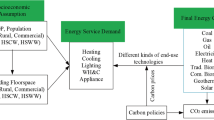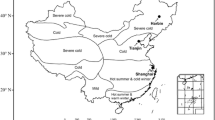Abstract
Climate change will affect the energy system in a number of ways, one of which is through changes in demands for heating and cooling in buildings. Understanding the potential effect of climate change on heating and cooling demands requires taking into account not only the manner in which the building sector might evolve over time, but also important uncertainty about the nature of climate change itself. In this study, we explore the uncertainty in climate change impacts on heating and cooling requirement by constructing estimates of heating and cooling degree days (HDD/CDDs) for both reference (no-policy) and 550 ppmv CO2 concentration pathways built from three different Global Climate Models (GCMs) output and three scenarios of gridded population distribution. The implications that changing climate and population distribution might have for building energy consumption in the U.S. and China are then explored by using the results of HDD/CDDs as inputs to a detailed, building energy model, nested in the long-term global integrated assessment framework, Global Change Assessment Model (GCAM). The results across the modeled changes in climate and population distributions indicate that unabated climate change would cause building sector’s final energy consumption to decrease modestly (6 % decrease or less depending on climate models) in both the U.S. and China by the end of the century as decreased heating consumption more than offsets increased cooling using primarily electricity. However, global climate change virtually has negligible effect on total CO2 emissions in the buildings sector in both countries. The results also indicate more substantial implications for the fuel mix with increases in electricity and decreases in other fuels, which may be consistent with climate mitigation goals. The variation in results across all scenarios due to variation of population distribution is smaller than variation due to the use of different climate models.






Similar content being viewed by others
Explore related subjects
Discover the latest articles and news from researchers in related subjects, suggested using machine learning.Notes
Traditional energy refers to unsustainable use of wood, charcoal, agricultural residues, and animal dung for cooking and heating in the residential sector (Edenhofer et al. 2011). Its typical conversion efficiency is substantially lower than other commercial fuels.
A similar trend was observed when we compare cumulative heating and cooling energy demands through 2050, a time horizon that policy makers might have on their agenda, although the net impact is smaller than the century-long cumulative value.
Abated climate change (550 ppmv) decreases cumulative direct CO2 emissions (2005–2095) by 2–3 %, compared to the effect of full climate change of around 11 % in both countries. The numbers become much smaller in terms of cumulative total emissions.
References
Amato A, Ruth M, Kirshen P et al (2005) Regional energy demand responses to climate change: methodology and application to the commonwealth of Massachusetts. Clim Chang 71:175–201
Baumert K, Selman M (2003) Heating and cooling degree days. World Resources Institute
Büyükalaca O, Bulut H, Yilmaz T (2001) Analysis of variable-base heating and cooling degree-days for Turkey. Appl Energy 69(4):269–283
Collins WD, Bitz CM, Blackmon ML et al (2006) The Community Climate System Model Version 3 (CCSM3). J Clim 19(11):2122–2143
Daioglou V, Van Ruijven BJ, Van Vuuren DP (2012) Model projections for household energy use in developing countries. Energy 37(1):601–615
Day T (2006) Degree days: Theory and application. The Chartered Institution of Building Services Engineers, London
Edenhofer O, Pichs-Madruga R, Sokona Y et al (2011) Renewable energy sources and climate change mitigation: Special report of the intergovernmental panel on climate change. Cambridge University Press, Cambridge
Edmonds J, Clarke J, Dooley J et al (2004) Stabilization of CO2 in a B2 world: insights on the roles of carbon capture and disposal, hydrogen, and transportation technologies. Energy Econ 26(4):517–537
Edmonds J, Wilson T, Wise M et al (2006) Electrification of the economy and CO2 emissions mitigation. Environ Econ Policy Stud 7(3):175–203
Eom J, Clarke L, Kim S et al (2012) China’s building energy use: A long-term perspective based on a detailed assessment. PNNL, Richland
Giannakopoulos C, Psiloglou BE (2006) Trends in energy load demand for Athens, Greece: weather and non-weather related factors. Clim Res 31(1):97–108
Gordon C, Cooper C, Senior CA et al (2000) The simulation of SST, sea ice extents and ocean heat transports in a version of the Hadley Centre coupled model without flux adjustments. Clim Dyn 16(2):147–168
Grübler A, O’Neill B, Riahi K et al (2007) Regional, national, and spatially explicit scenarios of demographic and economic change based on SRES. Technol Forecast Soc Chang 74(7):980–1029
IPCC (2000) Emissions scenarios. Intergovernmental panel on climate change. Cambridge
Isaac M, van Vuuren DP (2009) Modeling global residential sector energy demand for heating and air conditioning in the context of climate change. Energy Policy 37(2):507–521
Krey V, O’Neill B, Ruijven BV et al (2012) Urban and rural energy use and greenhouse gas emissions in Asia. Energ Econ 34 (Suppl 3):S272–S283
Kyle P, Clarke L, Rong F et al (2010) Climate policy and the long-term evolution of the U.S. buildings sector. Energy J 31(3):131–158
Mendelsohn R, Morrison W, Schlesinger M et al (2000) Country-specific market impacts of climate change. Clim Chang 45:553–569
Mideksa TK, Kallbekken S (2010) The impact of climate change on the electricity market: a review. Energy Policy 38(7):3579–3585
Nakicenovic N, Alcamo J, Davis G et al. (2000) Special report on emissions scenarios. Cambridge
Olonscheck M, Holsten A, Kropp J (2011) Heating and cooling energy demand and related emissions of the German residential building stock under climate change. Energy Policy 39(9):4795–4806
Russell GL, Miller JR, Rind D et al (2000) Comparison of model and observed regional temperature changes during the past 40 years. J Geophys Res 105(D11):14891–14898
Sailor D (2001) Relating residential and commercial sector electricity loads to climate-evaluating state level sensitivities and vulnerabilities. Energy 26:645–657
Scott MJ, Huang YJ (2007) Effects of climate change on energy use in the United States. In: Effects of climate change on energy production and use in the United States. A report by the U.S. climate change science program and the subcommittee on global change research. Washington, pp 7–28
van Ruijven BJ, van Vuuren DP, de Vries BJM et al (2011) Model projections for household energy use in India. Energy Policy 39(12):7747–7761
Wilbanks T, Romero-Lankao P, Bao M et al (2007) Industry, settlement and society. In: Parry ML et al (eds) Climate Change 2007 - Impacts, adaptation and vulnerability. Contribution of working group II to the fourth assessment report of the intergovernmental panel on climate change. Cambridge University Press, Cambridge, pp 357–390
Wilbanks TJ, Bhatt V, Bilello DE (2008) Effects of climate change on energy production and use in the United States, synthesis and assessment product 4.5. US Climate Change Science Program, Washington
Xu P, Huang YJ, Miller N et al (2009) Effects of global climate changes on building energy consumption and its implications on building energy codes and policy in California: PIER final project report. California Energy Commission, Berkeley, CA
Acknowledgments
The authors are grateful for research support provided by Environmental Protection Agency, the Global Technology Strategy Project, and the Integrated Assessment Research Program in the Office of Science of the U.S. Department of Energy for funding this research. The Pacific Northwest National Laboratory is operated for DOE by Battelle Memorial Institute under contract DE‐AC05‐76RL01830. The authors would like to thank James J. Dooley and three anonymous reviewers for constructive comments and the many colleagues and organizations that shared data used in this project. The views and opinions expressed in this paper are those of the authors alone.
Author information
Authors and Affiliations
Corresponding author
Electronic supplementary material
Below is the link to the electronic supplementary material.
ESM 1
(DOCX 4617 kb)
Rights and permissions
About this article
Cite this article
Zhou, Y., Eom, J. & Clarke, L. The effect of global climate change, population distribution, and climate mitigation on building energy use in the U.S. and China. Climatic Change 119, 979–992 (2013). https://doi.org/10.1007/s10584-013-0772-x
Received:
Accepted:
Published:
Issue Date:
DOI: https://doi.org/10.1007/s10584-013-0772-x




